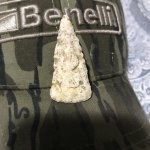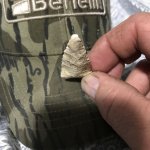Welcome Guest!
You are using an out of date browser. It may not display this or other websites correctly.
You should upgrade or use an alternative browser.
You should upgrade or use an alternative browser.
ID Help
- Thread starter Ruger2506
- Start date
Did you find this in Southeast Alabama, Southwest Georgia, or the Panhandle of Florida where the three states join?
I'd call that an almost-finished preform, before notching or stemming took place.
It looks like an un-notched type 2 Boggy Branch.
Ruger2506
Member
Did you find this in Southeast Alabama, Southwest Georgia, or the Panhandle of Florida where the three states join?
Worth County
Ruger2506
Member
It looks like an un-notched type 2 Boggy Branch.
I thought the same thing Nic, but wasn’t sure.
I’m not any help , but it’s a mighty fine find !
longrangedog
Senior Member
I'd call that an almost-finished preform, before notching or stemming took place.
I think that the fact that the base is beveled indicates that the piece is finished as is.
I don't. As a flintknapper, I can tell you that thinning the base like that is the first preparation for notching or stemming. Also, it's still missing the final runs of pressure flaking to straighten, center, and sharpen the edges.I think that the fact that the base is beveled indicates that the piece is finished as is.
Ruger2506
Member
The base appears to be ground, if that matters at all.
Anyway, thanks for the info guys.
Anyway, thanks for the info guys.
longrangedog
Senior Member
Not being a flintknapper, I'll defer to your judgement.
Redbow
Senior Member
Its a nice artifact, wish I could find one like that.
swampstalker
Senior Member
Boggy
Grinding the thin edges is standard prep before pressure flaking, notching, or stemming.The base appears to be ground, if that matters at all.
Anyway, thanks for the info guys.
Similar threads
- Replies
- 10
- Views
- 2K




